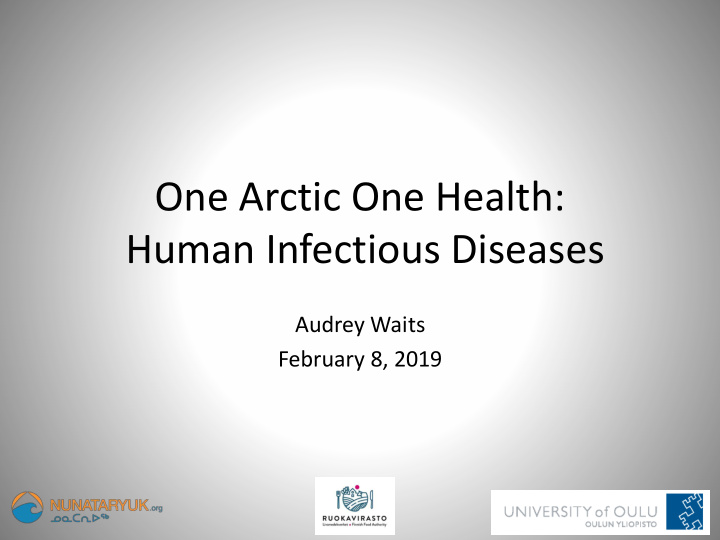



One Arctic One Health: Human Infectious Diseases Audrey Waits February 8, 2019
NASA GISS https://nsidc.org/cryosphere/arctic-meteorology/climate_change.html
1 2 3 1. Richard Reid, Nat Geo Image Collection https://news.nationalgeographic.com/2018/03/winter-arctic-sea-ice-second-lowest-record-spd/ 2. https://www.nationalgeographic.com/environment/2018/08/news-arctic-permafrost-may-thaw-faster-than-expected/ 3. Audrey Waits, Oulu Finland
CLIMATE CHANGE HUMAN MILDER WINTERS, EXPANSION OF DEVELOPMENT WARMER SUMMERS BOREAL TREE LINE ENVIRONMENT/ HABITAT CHANGES PERMAFROST MELTING BETTER SURVIVAL FOR VECTORS ONE HEALTH CONTAMINANTS ENVIRONMENT- WILDLIFE- POLLUTION IN FOOD HUMAN INTERACTION ZOONOTIC AND VECTOR-BORNE DISEASES EXPSOSURE TO CONTAMINANTS AS NEW POPULATIONS ENVIRONMENTAL STRESSORS FOOD- AND WATERBORNE DISEASES PEOPLE SPENDING PREVENTION & MORE TIME OUTSIDE SURVEILLANCE CHANGES IN • EDUCATION TRADITIONAL FOOD DISRUPTION IN STORAGE SANITATION • VACCINATION INFRASTRUCTURE • DATA COLLECTION HUMAN- CAUSED CHANGE
Systematic Review • To compile recent studies in this field and compare them to a previous review (Hedlund et. al 2014) • English searches conducted in PubMed, ScienceDirect, Scopus, and PLOS One • Russian searches conducted in the Scientific Electronic Library “eLibrary.ru” • Searches conducted in March 2018
Scopus PubMed ScienceDirect Initial search results Initial search results Initial search results (n=156) (n=27) (n=674) Articles selected for full text review Articles selected for full text review Articles selected for full text review (n=14) (n=6) (n=73) Articles included in review Articles included in review Articles included in review (n=1) (n=0) (n=20) PLOS One eLibrary.ru Initial search results Initial search results (n=58) (n=2377) Total search results: (n= 3292) Articles selected for full text review Articles selected for full text review (n=2) (number of articles not recorded) Articles included in review: (n= 43) Articles included in review Articles included in review (n=21) (n=1) Waits et al. (2018) Human infectious diseases and the changing climate in the Arctic. Envir Int 121 703-713
Results • Zoonotic/ vector-borne diseases (n= 29, 67%) – Tick-borne diseases (n= 10) – Tularemia (n= 9) – Anthrax (n= 6) • Food- and waterborne diseases (n= 6, 14%) – Vibriosis (n=4) • Airborne diseases (n= 2, 5%) 3 2 1 1 https://www.thelocal.ch/20190204/swiss-government-extends-vaccination-area-for-tick-borne-encephalitis-as-cases-increase 2 https://www.independent.co.uk/travel/europe/active-finland-travellers-guide-9614065.html 3 https://www.thesinusdoctor.com/what-does-it-mean-when-you-cant-stop-sneezing/
Airborne diseases • Influenza A and human rhinovirus were investigated in relation to temperature and humidity • Abundance of co-factors • Low publication numbers • Difficult to establish an association
Food- and waterborne diseases • Lack of sanitation/ water infrastructure • Increased temperature and precipitation • Disruption of waste and sanitation infrastructure • Increased use of public bathing areas • Vibriosis – Associated with increases in sea surface temperature
Vector-borne diseases and zoonoses Tick-borne diseases Tularemia • Tick borne encephalitis • Climatic and ecological (TBE) factors play important role in determining vector range • Tick borne borreliosis (TBB) and population • Warmer temperatures affect habitat and life cycle
Anthrax • Permafrost thaw exposes buried carcasses of infected animals • Primary method of exposure is contact with infected animals • Low or absent vaccination
• Main focus of the 72 articles included in this review (n=43) and a previous review (n=29) (Hedlund et al. 2014) divided by country • All articles published between 1970-2017 • “Other” includes articles covering more than 1 country Waits et al. (2018) Human infectious diseases and the changing climate in the Arctic. Envir Int 121 703-713
Climate and health research by geographic region • PubMed search only • Used UN designated regions • Made category for Arctic htps://commons.wikimedia.org/wiki/File:United_Nations_geographical_subregions.png
Northern Africa Pacific Islands 2 %Eastern Africa Arctic 1% 8 % 4 % Middle Africa 3 % Australia and New Zealand Southern Africa 4 % 3 % Western Africa 6 % Western Europe Caribbean 1 % 10 % Central America 2 % Southern Europe South America 1 % 6 % Northern Europe 7 % Eastern Europe North America 4 % 13 % Western Asia Central Asia 8 % 1 % Eastern Asia Southern Asia South-eastern Asia 9 % 6 % 3 % Total of 58, 563 search results Waits et al. (2018) Human infectious diseases and the changing climate in the Arctic. Envir Int 121 703-713
Conclusion • Increasing amount of research in the field published after 2010 • Tick-borne diseases, tularemia, anthrax, and vibriosis were the most researched infections likely to be impacted by climatic factors in the Arctic • Increased temperature and precipitation are predicted to be the most influential climatic factors • Surveillance, continued research, education, and vaccination can reduce the impact of climate associated changes in infections in the Arctic
Recommend
More recommend